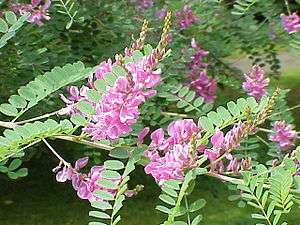Indigofera tinctoria
| Indigofera tinctoria | |
|---|---|
 | |
| Scientific classification | |
| Kingdom: | Plantae |
| (unranked): | Angiosperms |
| (unranked): | Eudicots |
| (unranked): | Rosids |
| Order: | Fabales |
| Family: | Fabaceae |
| Genus: | Indigofera |
| Species: | I. tinctoria |
| Binomial name | |
| Indigofera tinctoria L. | |
| Synonyms[1] | |
| |
Indigofera tinctoria, also called true indigo, is a species of plant from the bean family that was one of the original sources of indigo dye. It has been naturalized to tropical and temperate Asia, as well as parts of Africa, but its native habitat is unknown since it has been in cultivation worldwide for many centuries. Today most dye is synthetic, but natural dye from I. tinctoria is still available, marketed as natural coloring where it is known as tarum in Indonesia and nila in Malaysia. In Iran and areas of former USSR known as basma. The plant is also widely grown as a soil-improving groundcover.
True indigo is a shrub one to two meters high. It may be an annual, biennial, or perennial, depending on the climate in which it is grown. It has light green pinnate leaves and sheafs of pink or violet flowers. The plant is a legume, so it is rotated into fields to improve the soil in the same way that other legume crops such as alfalfa and beans are.
Dye is obtained from the processing of the plant's leaves. They are soaked in water and fermented in order to convert the glycoside indican naturally present in the plant to the blue dye indigotin. The precipitate from the fermented leaf solution is mixed with a strong base such as lye.
The rotenoids deguelin, dehydrodeguelin, rotenol, rotenone, tephrosin and sumatrol can be found in I. tinctoria.[2]
Marco Polo (13th century) was the first to report on the preparation of indigo in India. Indigo was quite often used in European easel painting since the Middle Ages.[3]
Further reading
- Feeser, Andrea. Red, White, and Black Make Blue: Indigo in the Fabric of Colonial South Carolina Life (University of Georgia Press; 2013) 140 pages; scholarly study explains how the plant's popularity as a dye bound together local and transatlantic communities, slave and free, in the 18th century.
References
- ↑ "The Plant List: A Working List of All Plant Species".
- ↑ In vivo and in vitro investigations on rotenoids from Indigofera tinctoria and their bioefficacy against the larvae of Anopheles stephensi and adults of Calmlosobruchus chinensis. Kamal R. and Mangla M., Journal of biosciences, 1993, vol. 18, no. 1, pp. 93-101
- ↑ Pigments through the ages